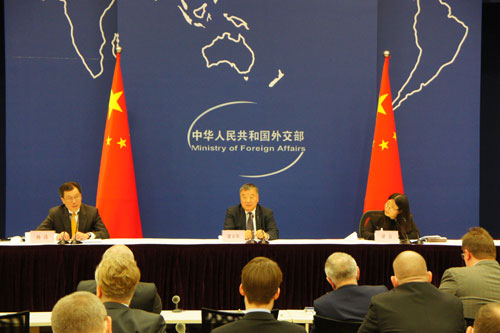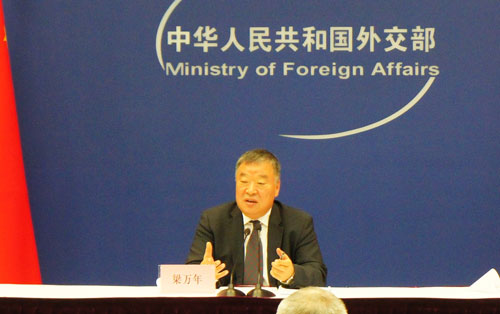
On March 12, 2021, the Ministry of Foreign Affairs held a briefing to European envoys on the joint scientific research on the origins of the novel coronavirus conducted by China and the WHO. The briefing was chaired by Director-General of the Department of International Organizations and Conferences of the Foreign Ministry Yang Tao. Team leader from the Chinese side of the China-WHO joint expert team Professor Liang Wannian provided relevant information about the study and answered questions. Over 40 European envoys and diplomats from 29 European countries and the European Union attended the briefing.

Liang Wannian provided detailed information about the background, process, findings and suggestions about future research of the China-WHO joint study. He said that after relevant resolutions were approved at the 73rd World Health Assembly, China overcame the pressure of epidemic prevention and control within its borders and took the lead to carry out a joint study on the origins of the novel coronavirus with the WHO. In July 2020, China invited WHO experts to come to China and both sides agreed on the WHO-convened Global Study of the Origins of SARS-CoV-2: Terms of References for the China Part. According to the agreed terms of references (ToR), China set up a joint expert team with international experts from the WHO, and conducted a 28-day joint study from January 14 to February 10 this year in Wuhan. During the visit in Wuhan, experts from both sides visited 9 places, including Jinyintan Hospital, Huanan Seafood Market, and the Wuhan Institute of Virology under the Chinese Academy of Sciences. The team also visited and talked with local medical workers, lab researchers, scientists, market managers, business owners, community workers, recovered patients, and families of medical workers losing their lives in the epidemic. A number of meetings, consultations and discussions were held to accumulate scientific consensus on the origins of the novel coronavirus. And sound working relations were built between experts of both sides through in-depth and candid exchanges.
Liang Wannian said that the joint study has achieved positive outcomes and reached some findings and conclusions, thanks to efforts from the two sides: First, coronaviruses with high similarity to SARS-CoV-2 in gene sequences in bats and pangolins were found by the joint expert team. But the similarity is still not enough to make it a direct ancestor of SARS-CoV-2. Other species all could be potential natural hosts. Second, the first case in Wuhan got sick on December 8, 2019. The Huanan Seafood Market could be an outbreak site and amplifier of the COVID-19 pandemic. Third, environmental sampling in the Huanan Seafood Market from right at the point of its closing revealed widespread contamination of surfaces with the virus, especially in its aquatic product stalls. The coronavirus at the market might has been introduced through infected people or contaminated cold-chain products, animals, and animal products. After scientific assessment, the joint expert team believes the SARS-CoV-2 virus is "most likely" to be introduced through an intermediary host species, "likely" to be introduced through direct transmission or cold-chain food, and "extremely unlikely" to be introduced through a laboratory incident.
Liang Wannian pointed out that the joint expert team puts forward four suggestions in terms of future study. First, expand globally unified database, including molecule, gene sequence, clinic, epidemiology, animal monitoring and environmental monitoring data. Second, continue to look for more possible early cases in a wider range around the globe. Third, scientists around the world should search animal species that may become virus hosts in many countries and places, not limited to bats. Fourth, further understand the role of cold chain and frozen food in virus transmission.

